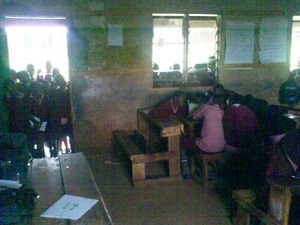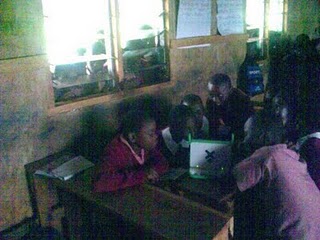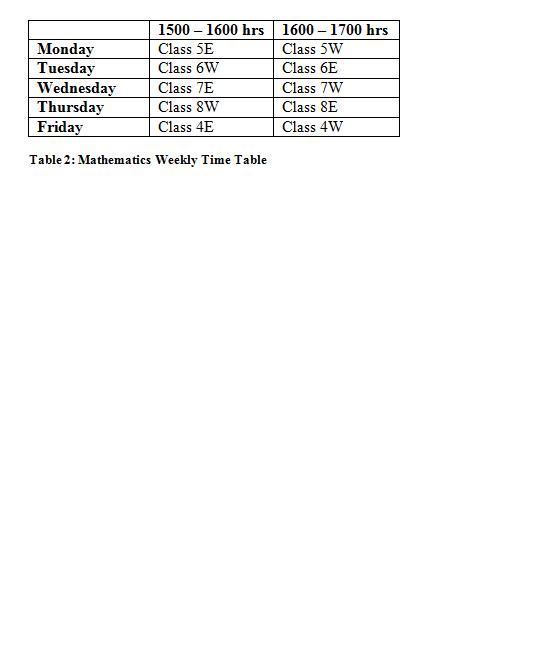Projects/KenyaSmallSolutions HOC KeongoSchool
< Projects
Jump to navigation
Jump to search
Introduction SmallSolutions_HOC_KeongoSchool
- Shipping Address:
- Hands for Charity
- Off Thika Road
- Along Kasarani Mwiki Road at Seasons Stage
- Mark Bill Koech c/o Theresa Okello
- (254) -734-771-385
- Number of You Request to Borrow: 7
- Loan Length—How Many Months: January to April 2010
Project Members
- Mark Koech (Team Leader)
- Email: billiago@gmail.com
- Education: Student, United States International University, B.Sc, Information Systems and Technology
- A-level Certificate, 2006
- O-level Certificate, 2004
- Sandra Thaxter (Small Solutions)
- Software Engineer; Systems Architect; Field Engineer at UNICEF ; Lotus; ; UNICEF: IBM; Whitesmiths; Think Technologies
- International Education: Youth for Understanding
- Secondary School Language Teacher: Governor Dummer Academy; Ipswich High School; alternative schools.
- Small Solutions: Founder and Director
- Languages: French, German, Russian, and some Spanish
- Education: Graduate Studies Engineering and Business: Comparative Literature; French;
- Elias Kimaiga Moregi
- Education: KCA University BCOM and CPA
- Accounts Clerk Nyakach Girls’ High School
- Profession: Teacher, Matongo Mixed Secondary School
- Stephen Sawa
- Education:
- Diploma, Primary School Science
- Certificate in Social work
- Profession: Head Master, St. Aloys Academy
- Maruti J. Soita
- Education: Masters Degree, Education, Kenyatta University
- Bachelors Degree, Education, University of Nairobi
- Profession: Teacher, Chejamisi Girls’ High School
- Elizabeth Ogutu
- Education: Student, United States International University, BA Accounting
Objectives XO Teaching Mathematics in Kenya
- To use the XO to challenge students in learning of Mathematics by engaging in problem solving projects that require the use of mathematical concepts that are required by the Kenyan Standard Syllabus and teach abstract concepts beyond the scope of the traditional skill sets.
- An example of a learning task would be to use Scratch or Turtle Art to create a program which would draw a polygon of any number of sides without requiring any previous knowledge of angles. This would involve variables, recursion, successive approximations and the use of abstact concepts.
- Teams of three are assigned to each class, and include guidance to students, and observation, and progress evaluation.
- The teams will locate a library center where the provided XOs will be setup for after school and weekend access to learning.
- We expect to raise the average percentage mark of all the children by 20% by the end of the three months and our goal is to measure and track the skill acquisition in the monthly CATs (Continuous Assessment Tests).
Plan of Action
- Six hundred children will benefit from our programs in two districts in Kenya, Kericho and Bungoma, which will run for 12 weeks, from 11th January 2010 to 2nd April 2010. The program will be implemented on the ground by six volunteers, divided into two groups each in one district, recruited by the organization.
- Hands of Charity wants begin reversing the erosion and poor performance in Kenyan Primary Schools. We are targeting Primary School children (between 10 and 14 years) for teaching mathematics using the XO laptop.
Needs
- With a decreasing number of children finishing Primary School and an even smaller percentage who finish Secondary School, children in schools clearly lack direction and a purpose for school.
- In the target school in Kericho district, Keongo Primary School, nearly 250 children join primary school at the age of 6 to 8, yet only an average of 158 successfully complete the 8 year course. This high drop out rate is caused by lack of money, children orphaned by HIV/AIDS and living with relatives, and a lack of interest because students have little experience outside their communities. Students are constantly castigated by teachers driving these children into finding school a torture forced upon them by their parents.
- When these children decide to drop out, they start looking for ways to earn a living, or get drawn into negative activities like drug abuse and sex.
- Some of these children do indeed finish Primary School and progress to Secondary School. Here, the story of low motivation, the absence of learning material and the extremely theoretical teaching methods continues.
- Unfortunately for Kenya, the free Primary and Secondary education introduced a few years ago has left most schools with insufficient resources to handle the overwhelmingly large number of children who are admitted every year.
Methods
- The two teams, the Kericho Team and the Bungoma Team, shall start teaching at the same time in their respective schools in order to maximize available computers, which are few in number.
- The XO activities have been designed to use Pippy and Turtle Art to teach by discovery mathematical concepts : addition, multiplication, subtraction and division, angles, fractions, ratios, percentage, variable use and basic algebra. This teaching will be done in groups to help breed a culture of collective success and to utilise the few laptops available.
- There will be two classes per day in each school. Each class will have a tutor, his assistant and the supervisor. As one tutors his/her respective subject, a volunteer member of the community or one of the school’s teachers will assist him help the pupils with the XO laptops and keep the class in order. The supervising teacher is to ensure smooth running of the classes and is also responsible for the facilitation of the tutors, the co-ordinator of his team’s activities and the link between the HOC headquarters, the school and his team. He/she is also responsible for updating the HOC blog (hoclaptop.blog.com).
Curriculum
- The XOs also have activities like Pippy and Turtle Art that will be used to test if basic Mathematical concepts like addition, multiplication, subtraction and division, as well as angles, fractions, ratios, percentage and basic algebra have been understood. What the children score in these tests will be recorded and the weekly data represented by a line graph to show the progress they have made. This will also be done in groups to help breed a culture of collective success and to utilise the few laptops available.
- The aim of this curriculum is to improve performance of Mathematics, and these are the areas we aim to improve by the end of the three month period.
- After schools and during the weekend the XOs will be available to students either in the school or at a commonly accessible location in the village.
XO Mathematics Curriculum
- Week 1: Review of XO features and specifically the features of Turtle Math and Pippy activities
- Week 2: Present Problem Solving tasks to visualize addition, subtraction, multiplication and division by using Turtle Art to create basic geometic objects. Introduction of algebraic concepts (addition and subtraction of one or more unknowns, multiplication and division of one or more unknowns, calculation of values of unknowns, substitution of unknowns into equations).
- Week 3: Using Turtle Art and Pippy explore measurement systems, solve problems of length and distance, introduce Kinematics by making Turtle objects move; in addition use outdoor activities to experience the concepts taught in measurement.
- Week 4: CATS
- Week 5: Reading Time (analogue and digital); Time conversion; Time measurement of human movement; efficiency and speed measured in outdoor activities. Use the XO chart tool and “Measure” to illustrate these concepts. XO to create programs to create a number conversion chart.
- Week 6: Using Scratch or Turtle Art to learn about angles. Create Scratch or Turtle program to draw a polygon of any number of sides. This would involve creating angles, recursion, successive approximations and the use of variables Apply what was learning in Turtle Geometry to conventional geometry calculating angles between lines; bisection of angles ; the triangle: properties, explanation of the Pythagoras theorem; Outdoor activities will reinforce practical use of angles: marking the sports field.
- Week 7: Use a chart to track measurement of mass; identification of common metric, show mass to density and volume; density of solids and liquids.
Measuring Outcomes
- Measurement will use the outcomes of the Kenyan CAT tests (Continuous Assessment Tests) that are used by all Kenyan schools.
- The test results will be measured against the skills taught during XO sessions with Turtle Art and Pippy. The test outcomes will be recorded and the weekly data represented by a line graph to show skill development.
- The CATs given to the children test the children’s knowledge in all these fields. The supervising teacher will closely monitor the children’s results.
- At the end of the three months, the pupils will also be given special tests prepared by the HOC teams to test their progress in spelling, pronunciation and speech in English and computer proficiency.
- A full report will be prepared at the end of the three month period, detailing the progress on a weekly basis. A summarised version of this will then be published on the HOC website (under construction) and made available for all to read.
TimeFrame and Updates
- March 04, 2010 Update
- The full trial of the curriculum in the Keongo school has proved challenging because of the late arrival of the XOs to provide enough for the teaching, and because of the high cost of keeping the team on site. This curriculum project will move to the Bungoma school where these costs are lower. The 7 laptops have now arrived, and will provide the complement needed. However it is almost the end of this term, so we'd like to propose an extension to the borrowing time of all laptops through the spring term. A full proposal for the spring term work will be posted in the next few days. However the curriculum is the same, the plans for working in the Bungoma school will be posted. A plan to return to Keongo at some later time will also be planned.
- January 10 - April 2010
- Each respective team will leave Nairobi for Kericho and Bungoma, 300 km and 450 km respectively, on the 8th of January 2010. They will use the two days to settle and prepare for the classes starting the following Monday.
- Month 1 (January)
- Class Times: 1500 – 1600 1600 – 1700 (first month)
- The two teams, that is the Kericho Team and the Bungoma Team shall start teaching at the same time in their respective schools in order to maximise available computers, which are few in number.
- At the beginning, we need to have the children taught in the afternoon, making sure we do not interfere with the normal running of the school teaching program.
- Update January 14, 2010 As we are meant to target children between the ages of 6-12, the education levels in Kenya do not make it adequate enough to do so. We therefore decided to target children of the ages 10-14. The curriculum divided these children into five ‘classes’, (4, 5, 6, 7 and 8), based on the grade they are in. We are dealing with a large number of children here.
- Month 2 (February) (ongoing schedule Mathematics (see curriculum section)
- Month 3 (March)(schedule continues see Curriculum below)
- Month 4 (April) Measuring Outcomes
Staffing and Resources
- The field teams will be led by the Team Leaders, who are trained teachers charged with supervisory roles. The Kericho team will be led by Mark Bill Koech of Hands of Charity.
- Contact the team leader, Mark Bill Koech for more information. billmark@ymail.com or billiago@gmail.com
Sustainability
- Progress Reports on all the activities of the project will be posted on the HOC website.
- Hands of Charity Initiatives We hope to attract more funding to facilitate the next three month phase of the project (May, June and July).
- Funding and Partnership Small Solutions [www.smallsolutionsbigideas.org] has partnered with HOC and will be doing fundraising throughout this project, hoping to raise $3000 and applying for some grants to cover the remaining costs of the project.


